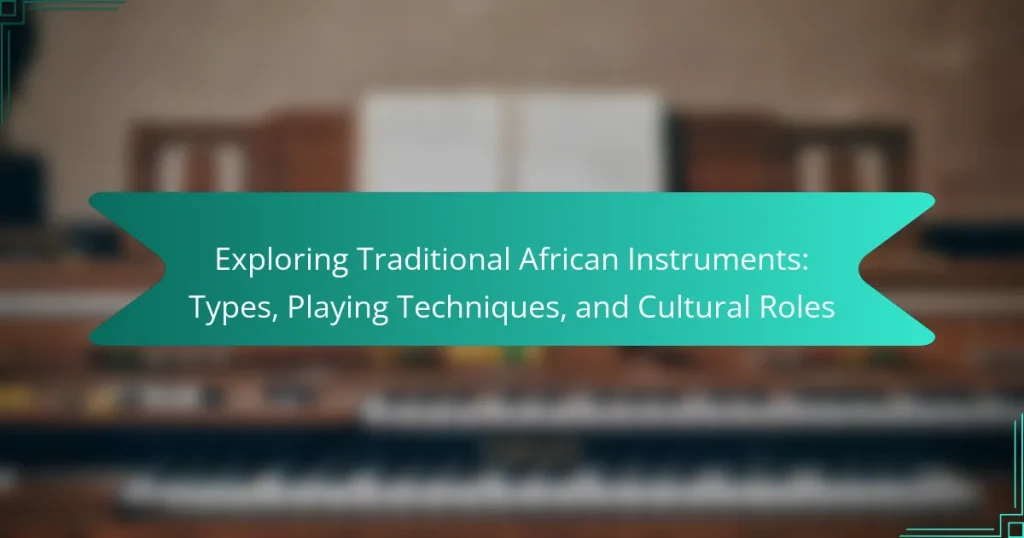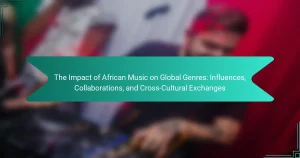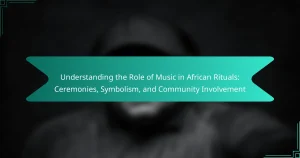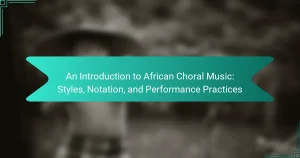Traditional African instruments encompass a diverse range of musical tools, including drums, stringed instruments, wind instruments, and percussion, each with distinct characteristics and playing techniques. Instruments such as the djembe and kora play significant roles in cultural identity, community cohesion, and ceremonial practices across the continent. The article explores various playing techniques, including plucking, striking, and blowing, which vary by region and instrument type. Additionally, it addresses modern adaptations of these instruments, highlighting their integration into contemporary musical genres and the ongoing efforts to preserve traditional techniques through education and collaboration. This examination underscores the dynamic relationship between heritage and modernity in African music.

What are Traditional African Instruments?
Traditional African instruments are musical tools used in various cultural contexts across the continent. These instruments include drums, stringed instruments, wind instruments, and percussion. Each type has unique characteristics and playing techniques. For instance, the djembe is a well-known drum played with the hands. Instruments like the kora combine strings and a resonating body, producing melodic sounds. Traditional African music often serves ceremonial, social, and spiritual purposes. Research indicates that these instruments play a vital role in cultural identity and community cohesion. They have been passed down through generations, preserving history and traditions.
How do Traditional African Instruments vary across different regions?
Traditional African instruments vary significantly across different regions, reflecting diverse cultural practices and musical traditions. In West Africa, instruments like the djembe and kora are prevalent, often used in communal celebrations. East Africa features the mbira and the adungu, which are integral to spiritual and social gatherings. Southern Africa showcases the marimba and the uhadi, emphasizing rhythmic and melodic complexity. North Africa presents instruments such as the oud and the guembri, often associated with folk music and storytelling. Each region’s instruments are crafted from locally available materials, influencing their sound and construction. These variations illustrate the rich tapestry of African musical heritage and its connection to cultural identity.
What are the key characteristics of instruments from West Africa?
Instruments from West Africa are characterized by their diverse forms, materials, and cultural significance. They often feature unique construction methods, utilizing local woods, animal skins, and metals. Percussion instruments, such as drums, are prevalent and integral to social and ceremonial events. String instruments, like the kora and ngoni, showcase intricate designs and tunings. Wind instruments, including flutes and horns, are commonly used in storytelling and rituals. Many instruments exhibit vibrant decorations that reflect the cultural heritage of specific communities. Additionally, the music produced by these instruments often serves as a means of communication and expression within the society.
What unique features define instruments from East Africa?
Instruments from East Africa are characterized by their use of indigenous materials and unique construction techniques. Many instruments are made from wood, animal skin, and metal. The kora, for example, features a gourd resonator and a long neck. Instruments often incorporate intricate carvings and designs that reflect cultural heritage. Rhythmic patterns are essential in their music, showcasing complex polyrhythms. Additionally, many instruments have a social or ceremonial role in communities. The use of call-and-response techniques is common in performances. This rich diversity in design and function highlights the cultural significance of East African instruments.
How do Southern African instruments differ from those in Northern Africa?
Southern African instruments typically utilize different materials and construction techniques compared to Northern African instruments. For instance, Southern African instruments often feature wooden bodies, while Northern African instruments may incorporate metal and skin. The mbira, a traditional Southern African thumb piano, contrasts with the oud, a string instrument common in Northern Africa. Additionally, Southern African music emphasizes rhythmic patterns, while Northern African music often focuses on melodic ornamentation. These distinctions reflect the diverse cultural influences and musical traditions in each region.
What types of Traditional African Instruments exist?
Traditional African instruments include a variety of types such as drums, string instruments, and wind instruments. Drums like the djembe and talking drum are central to many African cultures. String instruments include the kora, a harp-like instrument, and the ngoni, a traditional lute. Wind instruments feature the flute and the mbira, also known as the thumb piano. Each type plays a significant role in cultural rituals and storytelling. For example, the djembe is often used in celebrations and communal gatherings. The kora is traditionally played at important events like weddings. These instruments are integral to the musical heritage and social practices across the continent.
What are the main categories of Traditional African Instruments?
The main categories of Traditional African Instruments are percussion, string, and wind instruments. Percussion instruments include drums, rattles, and shakers. They are often used in ceremonies and celebrations. String instruments encompass lutes, harps, and fiddles. These instruments are typically used for storytelling and cultural expression. Wind instruments include flutes, horns, and reed instruments. They often accompany dances and rituals. Each category plays a significant role in the cultural heritage of various African communities.
How do percussion instruments contribute to African music?
Percussion instruments are fundamental to African music. They provide rhythm and drive, forming the backbone of many traditional musical styles. Instruments like drums, shakers, and bells create complex polyrhythms. These rhythms are essential for dance and community gatherings. Additionally, percussion instruments often carry cultural significance. They can denote social status or mark important rituals. The diversity of percussion instruments reflects the various ethnic groups across Africa. Each group has unique playing techniques and styles. This diversity enriches the overall musical landscape of the continent.
What role do string instruments play in traditional performances?
String instruments serve a vital role in traditional performances by providing melodic and rhythmic support. They often establish the emotional tone of the music. In many African cultures, these instruments are integral to storytelling and cultural expression. Instruments like the kora and mbira create intricate melodies that accompany vocal performances. They also facilitate community participation during ceremonies and celebrations. Historically, string instruments have been used to transmit oral traditions and cultural heritage. Their unique sounds can evoke specific emotions, enhancing the overall impact of the performance. Additionally, they often reflect the craftsmanship and cultural identity of the community.
How are wind instruments utilized in various cultural contexts?
Wind instruments are utilized in various cultural contexts to express identity, facilitate communication, and enhance rituals. In many African cultures, traditional wind instruments like the djembe and the flute are integral to ceremonies and celebrations. They often accompany dances and storytelling, serving as a means to connect communities. For instance, the Maasai people of Kenya use the long horn, called the orinka, during celebrations to signify social status and announce events. In contrast, the Native American flute is used for personal expression and healing, often played in solitude or during spiritual ceremonies. These instruments are not only musical tools but also cultural symbols that convey heritage and tradition.
What cultural roles do Traditional African Instruments play?
Traditional African instruments play significant cultural roles in various communities. They are integral to rituals, ceremonies, and celebrations. Instruments like the djembe and kora are used in storytelling and oral traditions. They facilitate communication between the spiritual and physical worlds. Traditional music often accompanies dances that express cultural identity. Instruments also serve educational purposes, teaching younger generations about heritage. Furthermore, they promote social cohesion by bringing communities together during events. The diversity of instruments reflects the rich cultural tapestry of Africa.
How are instruments used in rituals and ceremonies?
Instruments are integral to rituals and ceremonies, serving both spiritual and cultural purposes. They facilitate communication with the divine and enhance the atmosphere of the event. For example, drums often mark the rhythm of communal dances and signal important moments. Instruments like flutes and rattles are used to invoke spirits or ancestors during specific rites. The sound produced by these instruments is believed to carry prayers and intentions. Additionally, instruments can symbolize status or community identity within rituals. Their use is often deeply rooted in cultural traditions and practices, reflecting the values and beliefs of the community.
What significance do instruments hold in storytelling and oral traditions?
Instruments play a crucial role in storytelling and oral traditions. They enhance the narrative by providing emotional depth and atmosphere. Traditional African instruments, such as the kora and djembe, serve as both accompaniment and storytelling devices. These instruments help convey cultural values and historical events through music. For example, griots use instruments to narrate tales of ancestry and heritage. The rhythmic patterns and melodies evoke specific emotions, making stories more impactful. Instruments also facilitate community participation in storytelling, engaging audiences in a shared cultural experience. Their significance lies in their ability to bridge generations and preserve oral histories.
How do instruments facilitate community bonding and social gatherings?
Instruments facilitate community bonding and social gatherings by providing a medium for collective expression. They create opportunities for shared experiences during celebrations and rituals. Traditional African instruments, such as drums and flutes, are often central to social events. These instruments encourage participation and interaction among community members. Research shows that music-making fosters social cohesion and strengthens relationships. For example, communal drumming sessions can enhance feelings of belonging. The rhythmic patterns unite individuals, promoting a sense of togetherness. Instruments also serve as cultural symbols, representing community identity and heritage.
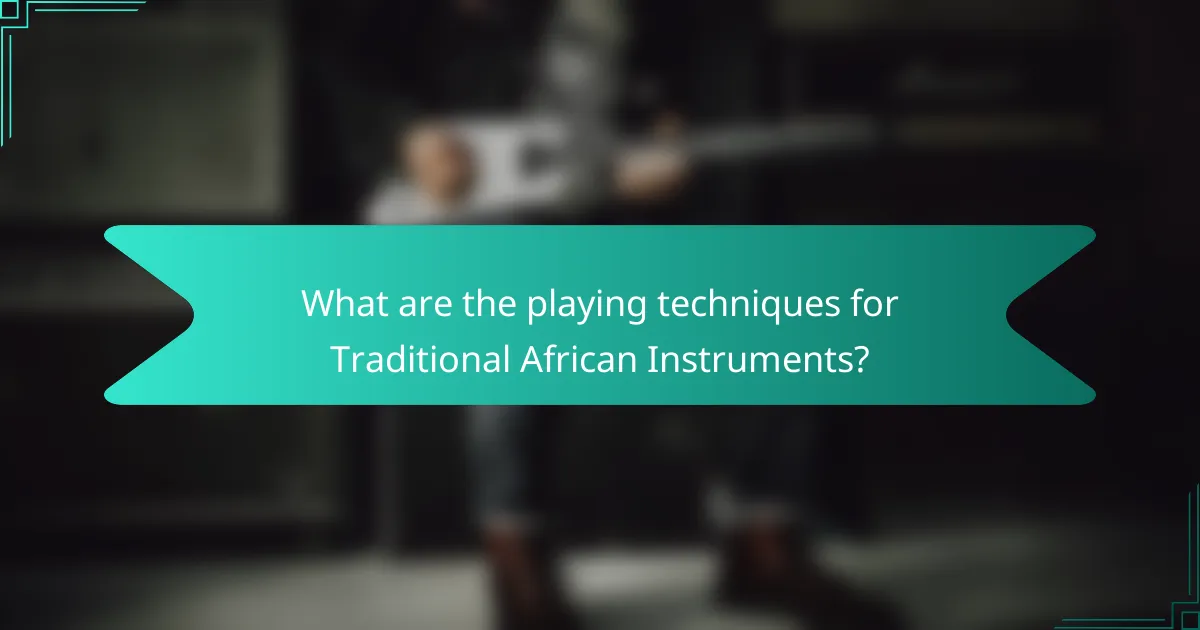
What are the playing techniques for Traditional African Instruments?
Traditional African instruments utilize various playing techniques. Techniques often include plucking, striking, and blowing. For string instruments like the kora, players use fingerpicking methods. Drumming techniques involve complex rhythms and polyrhythms, often played with hands or sticks. Wind instruments like the mbira require specific breath control and embouchure. Each technique varies by region and instrument type, reflecting cultural significance. For instance, the djembe drum is played with bare hands, producing unique tones. These techniques are passed down through generations, preserving cultural heritage.
How do musicians learn to play Traditional African Instruments?
Musicians learn to play Traditional African Instruments through a combination of oral tradition, mentorship, and practice. They often study under experienced players who provide hands-on instruction. This learning process emphasizes listening and imitation of rhythms and melodies. Musicians also participate in community events where they can practice in a social setting. Many instruments require specific techniques that are taught through demonstration. Cultural context plays a significant role in the learning process. Understanding the instrument’s significance enhances a musician’s connection to it. This method of learning preserves the musical heritage of various African cultures.
What traditional methods are used for teaching these instruments?
Traditional methods for teaching African instruments include oral transmission and apprenticeship. Oral transmission involves passing knowledge through storytelling and verbal instruction. Apprenticeship requires students to learn directly from experienced musicians. This method fosters practical skills and cultural understanding. Additionally, community participation is essential in the learning process. Learners often engage in group practice sessions. These sessions enhance collaborative skills and reinforce cultural ties. Instruments are typically taught in the context of traditional ceremonies and events. This approach ensures that the cultural significance of the music is preserved.
How do oral traditions influence the learning process?
Oral traditions significantly influence the learning process by facilitating knowledge transfer through storytelling and communal engagement. These traditions emphasize memory retention and active participation. Learners absorb cultural values and practical skills through narratives shared by elders. This method fosters a sense of identity and belonging among community members. Research indicates that oral traditions enhance cognitive development by encouraging critical thinking and reflection. For instance, studies show that children who engage with oral storytelling demonstrate improved language skills and comprehension. Therefore, oral traditions serve as vital educational tools in many cultures, particularly in African communities.
What techniques are commonly employed in playing these instruments?
Common techniques employed in playing traditional African instruments include rhythmic patterns, call-and-response, and polyrhythms. Rhythmic patterns are foundational in African music, providing structure and groove. Call-and-response techniques involve a leader playing a phrase, followed by a group response, fostering community participation. Polyrhythms are prevalent, where multiple contrasting rhythms are played simultaneously, creating complex textures. Instruments like the djembe utilize hand techniques for different tones, while string instruments may use plucking or bowing techniques. These methods contribute to the rich musical heritage and cultural expression found in African music traditions.
How do different playing styles affect the sound produced?
Different playing styles significantly affect the sound produced by traditional African instruments. Each style influences tone, volume, and rhythm. For example, a percussive playing style creates sharp, staccato sounds. This is evident in instruments like the djembe, where striking techniques vary the intensity of the beat. In contrast, a melodic playing style, such as that used with the kora, produces smooth, flowing notes. The use of fingerpicking versus strumming alters the instrument’s resonance and sustain. Additionally, the cultural context of each style shapes the sound. Traditional ceremonies often employ specific techniques to evoke particular emotions. Thus, the interplay between playing style and sound is crucial in traditional African music.
What role does improvisation play in performance?
Improvisation plays a crucial role in performance, especially in traditional African music. It allows musicians to express creativity and individuality. Each performance can vary significantly, reflecting the artist’s emotions and the audience’s reactions. Improvisation fosters a dynamic interaction between performers and their instruments. It encourages spontaneous collaboration among musicians. This practice is deeply rooted in African musical traditions, where oral transmission is key. Historical examples include the use of call-and-response patterns, which invite audience participation. The flexibility of improvisation enhances the cultural richness of performances.
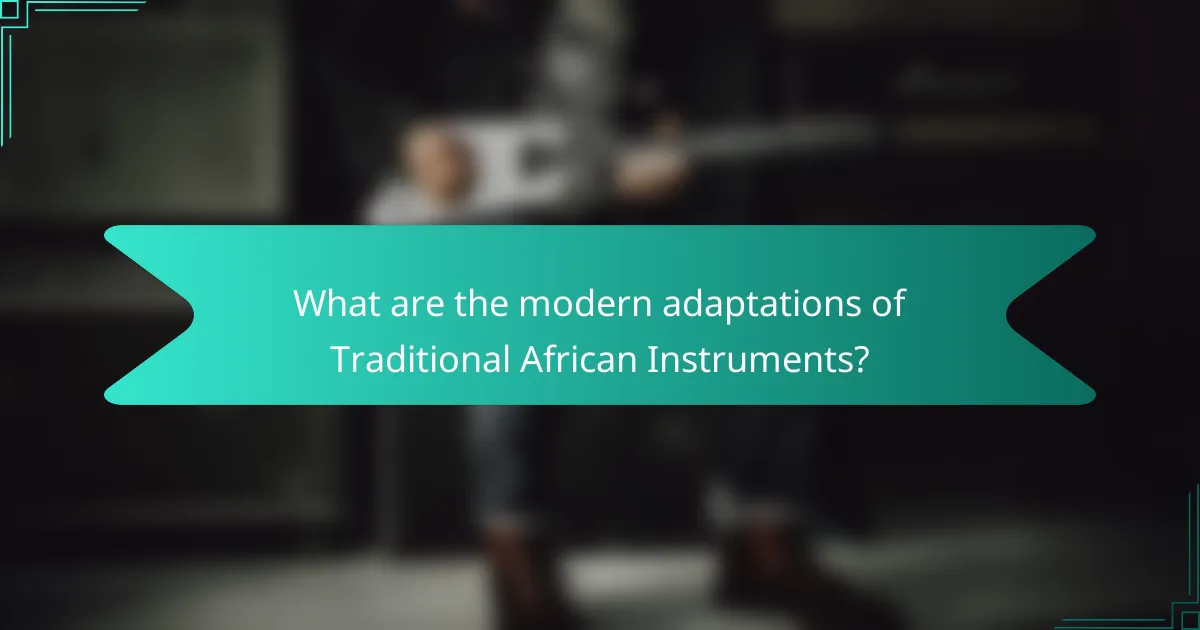
What are the modern adaptations of Traditional African Instruments?
Modern adaptations of traditional African instruments include the integration of electronic elements and contemporary musical genres. Instruments like the djembe and kora are now used in fusion genres, blending African rhythms with jazz, hip-hop, and pop music. Some musicians have modified traditional instruments to enhance their sound or playability. For instance, electric versions of the mbira have been created, allowing for amplification. Additionally, traditional techniques are being taught in modern music schools, ensuring their preservation and evolution. Collaborations between traditional musicians and contemporary artists further showcase these adaptations. These changes reflect a dynamic interaction between heritage and modernity in music.
How are Traditional African Instruments being integrated into contemporary music?
Traditional African instruments are integrated into contemporary music through collaboration and fusion. Artists incorporate traditional rhythms and melodies into modern genres like hip-hop, jazz, and pop. Instruments such as the djembe, kora, and mbira are frequently featured. This integration enhances the richness of contemporary soundscapes. Notable artists like Angelique Kidjo and Youssou N’Dour exemplify this trend. They blend traditional elements with global music styles. This practice promotes cultural exchange and appreciation. The result is a vibrant musical landscape that honors heritage while appealing to diverse audiences.
What fusion genres have emerged from this integration?
Fusion genres that have emerged from the integration of traditional African instruments include Afrobeat, world music, and jazz fusion. Afrobeat combines traditional African rhythms with jazz, funk, and highlife, popularized by artists like Fela Kuti. World music often incorporates African instruments alongside other global musical styles, creating diverse soundscapes. Jazz fusion integrates African percussion with jazz improvisation, seen in the works of musicians like Hugh Masekela. These genres reflect the cultural exchange and innovation stemming from the use of traditional African instruments in contemporary music.
How do artists maintain authenticity while modernizing these instruments?
Artists maintain authenticity while modernizing traditional African instruments by blending traditional techniques with contemporary styles. They often study historical playing methods to preserve the original sound and cultural significance. Incorporating modern technology, such as electronic effects, allows for innovative expressions without losing traditional roots. Collaborations with other genres can introduce new audiences while respecting the cultural context. Artists also prioritize storytelling and cultural narratives in their music, ensuring the essence remains intact. Research shows that maintaining a balance between innovation and tradition fosters appreciation for both the instruments and their cultural heritage.
What tips can musicians follow to master Traditional African Instruments?
Musicians can master Traditional African Instruments by practicing regularly and focusing on technique. Consistent practice helps develop muscle memory and familiarity with the instrument. Learning from skilled players is essential. This can provide insights into traditional playing styles and techniques. Understanding the cultural context is crucial. Each instrument has a unique role in its community. Listening to recordings of traditional music enhances familiarity with rhythms and melodies. Engaging with local musicians fosters a deeper connection to the music. Attending workshops or classes offers structured learning opportunities. These tips help musicians effectively master Traditional African Instruments.
What resources are available for learning and practicing these instruments?
Online courses and tutorials are available for learning traditional African instruments. Websites like Udemy and Coursera offer specific courses on various instruments. Video platforms like YouTube host numerous instructional videos from experienced musicians. Local music schools often provide classes focused on African music traditions. Community workshops and cultural centers may also offer hands-on learning experiences. Books and instructional manuals on traditional African music can be found in libraries and bookstores. Additionally, joining local music groups can facilitate practice and collaboration. These resources collectively support learners in mastering traditional African instruments.
How can musicians connect with traditional communities for authentic learning?
Musicians can connect with traditional communities for authentic learning by engaging with local cultural practices. They should participate in community events and festivals to immerse themselves in the culture. Building relationships with local musicians fosters trust and knowledge exchange. Collaborating on music projects can enhance understanding of traditional techniques. Attending workshops led by community elders provides direct learning opportunities. Documenting and sharing experiences can help preserve cultural heritage. Research shows that direct interaction enhances cultural appreciation and skill development. Engaging respectfully and openly is crucial for successful connections.
Traditional African instruments encompass a diverse range of musical tools, including drums, string instruments, and wind instruments, each with unique characteristics and cultural significance. The article explores the variations of these instruments across different regions of Africa, highlighting their roles in rituals, ceremonies, and community bonding. Key sections detail the playing techniques, learning methods, and modern adaptations of these instruments, emphasizing their importance in preserving cultural heritage. Additionally, the integration of traditional instruments into contemporary music and the emergence of fusion genres are examined, showcasing the dynamic relationship between tradition and modernity.
